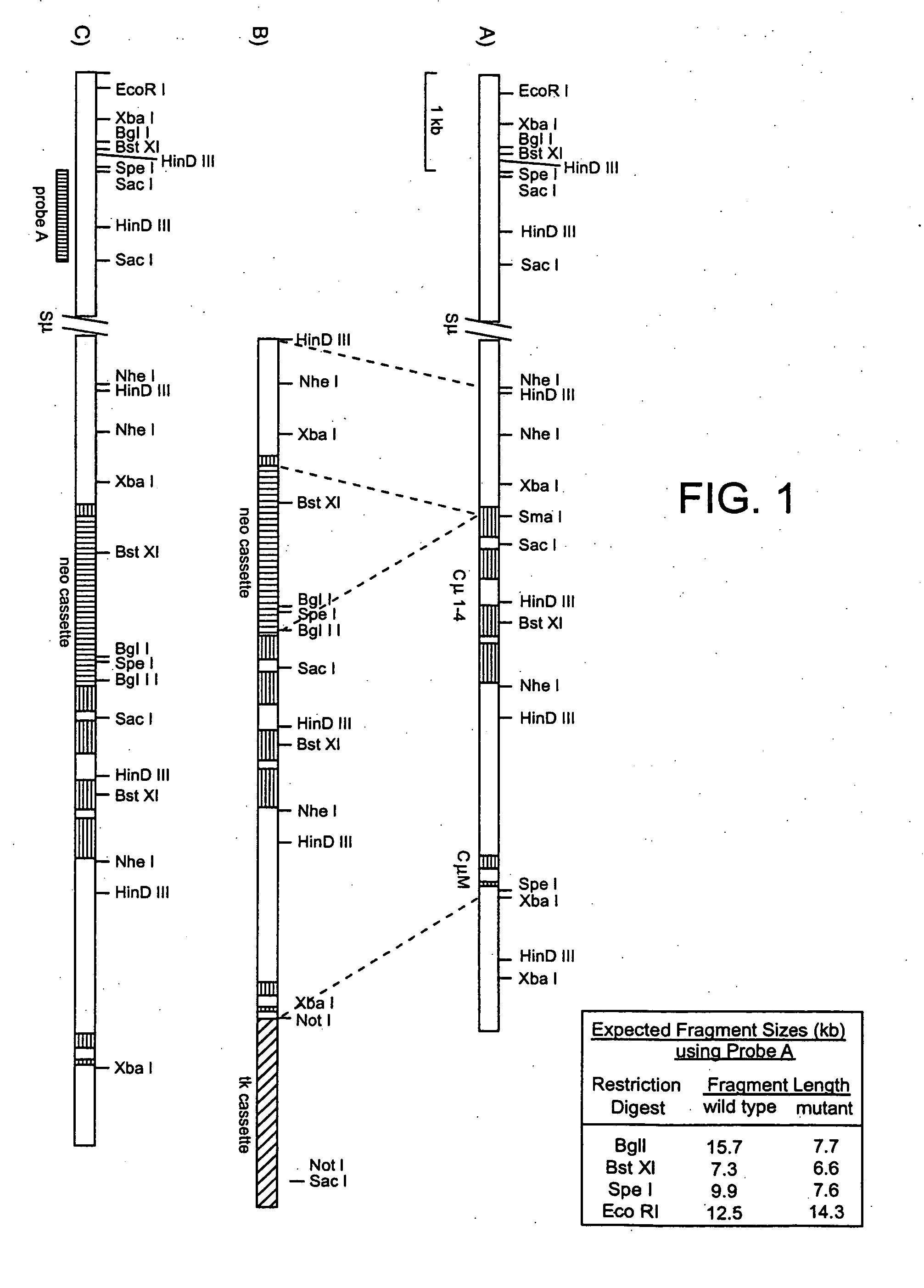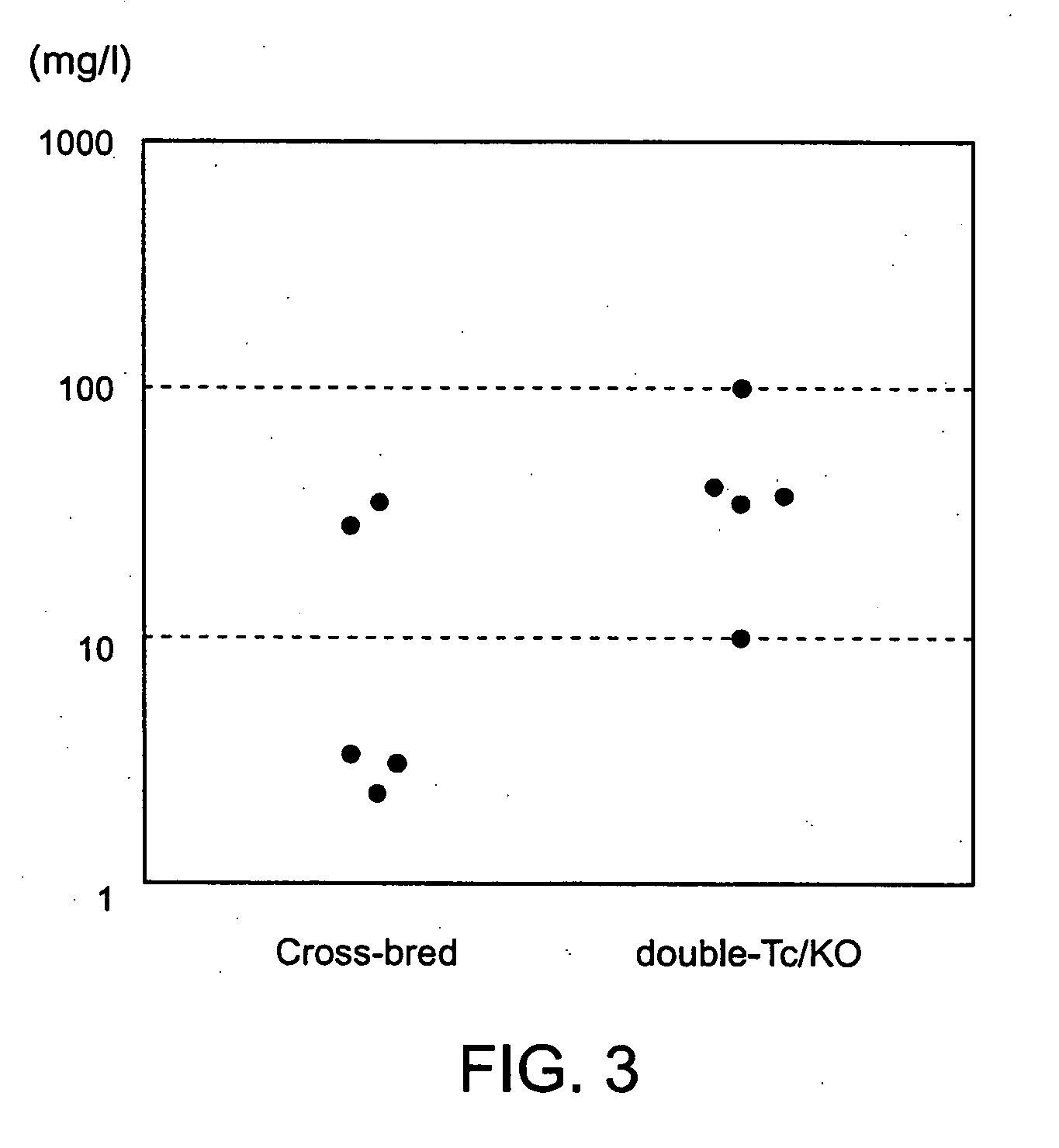Transgenic transchromosomal rodents for making human antibodies
a transchromosomal rodent and human antibody technology, applied in the field of transgenic animals, molecular immunology and medicine, can solve the problems of difficult cloning of over megabase-sized dna fragments encompassing whole human ig loci, limited human anti-mouse antibody response, etc., and achieve the effect of improving the stability of a transchromosomal mouse hybridoma cell
- Summary
- Abstract
- Description
- Claims
- Application Information
AI Technical Summary
Benefits of technology
Problems solved by technology
Method used
Image
Examples
example 1
Generation of Cmu Targeted Mice
[0201] Construction of a CMD targeting vector. The plasmid pICEmu contains an EcoRI / XhoI fragment of the murine Ig heavy chain locus, spanning the mu gene, that was obtained from a Balb / C genomic lambda phage library (Marcu et al., 1980, Cell 22:187). This genomic fragment was subcloned into the XhoI / EcoRI sites of the plasmid pICEMI9H (Marsh et al., 1984, Gene 32: 481-485). The heavy chain sequences included in pICEmu extend downstream of the EcoRI site located just 3′ of the mu intronic enhancer, to the xhoI site located approximately 1 kb downstream of the last transmembrane exon of the mu gene; however, much of the mu switch repeat region has been deleted by passage in E. coli.
[0202] The targeting vector was constructed as follows (see FIG. 1). A 1.3 kb HindIII / SmaI fragment was excised from pICEmu and subcloned into HindIII / SmaI digested pBluescript (Stratagene, La Jolla, Calif.). This pICEmu fragment extends from the HindIII site located approx...
example 2
The Human Kappa Light Chain Transgene KCo5
[0208] The generation of the human kappa light chain transgenic mouse line KCo5-9272 has been previously described KCo5 (Fishwild, D. et al., 1996, Nat. Biotechnol. 14, 845-851; Example 38 in U.S. Pat. No. 5,770,429). This line was generated by co-injection of an artificial human κ light chain locus and a YAC clone comprising multiple human V kappa segments. The YAC clone DNA was isolated from a yeast strain containing a 450 kb yeast artificial chromosome (YAC) comprising a portion of the human V kappa locus (ICRF YAC library designation 4×17E1). DNA sequence analysis of V gene segments amplified from the YAC DNA demonstrated that this clone comprised a substantial portion of the human distal V kappa region, including approximately 32 different V kappa segments. Analysis of a different isolate of this clone (Brensing-Kuppers, J., et al., 1997, Gene 191:173-181) confirmed that result, and also demonstrated that this clone represents an examp...
example 3
[0212] The human heavy chain locus containing chromosome 14 fragment hCF(SC20) and the human kappa light chain transgene were combined into a single strain by cross breeding. The hCF(SC20) transgenic mouse strain was homozygous for inactivation mutations of the endogenous heavy chain locus (CM2D) and the endogenous kappa light chain (CKD). This strain was also homozygous for λ1(low) mutation (Tomizuka, K. et al., 2000, Proc. Natl. Acad. Sci. U.S.A. 97:722-727). The CM2D mutation comprises a deletion of a 3.7 kb BamHI-XhoI segment covering part of Cmu2, Cmu3-Cmu4, and Mmu1 and Mmu2. The CKD mutation comprises a deletion of a 2 kb SacII-BglII segment covering the Ckappa exon. Both mutations have been previously reported (Tomizuka, K. et al., 2000, Proc. Natl. Acad. Sci. U.S.A. 97:722-727). These mice were bred with mice homozygous for the KCo5-9272 human kappa transgene insertion, and homozygous for the CMD and JKD disruptions of the endogenous heavy chain and kappa cha...
PUM
| Property | Measurement | Unit |
|---|---|---|
| Tm | aaaaa | aaaaa |
| temperature | aaaaa | aaaaa |
| temperature | aaaaa | aaaaa |
Abstract
Description
Claims
Application Information
 Login to View More
Login to View More - R&D
- Intellectual Property
- Life Sciences
- Materials
- Tech Scout
- Unparalleled Data Quality
- Higher Quality Content
- 60% Fewer Hallucinations
Browse by: Latest US Patents, China's latest patents, Technical Efficacy Thesaurus, Application Domain, Technology Topic, Popular Technical Reports.
© 2025 PatSnap. All rights reserved.Legal|Privacy policy|Modern Slavery Act Transparency Statement|Sitemap|About US| Contact US: help@patsnap.com



